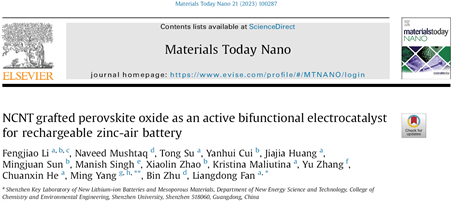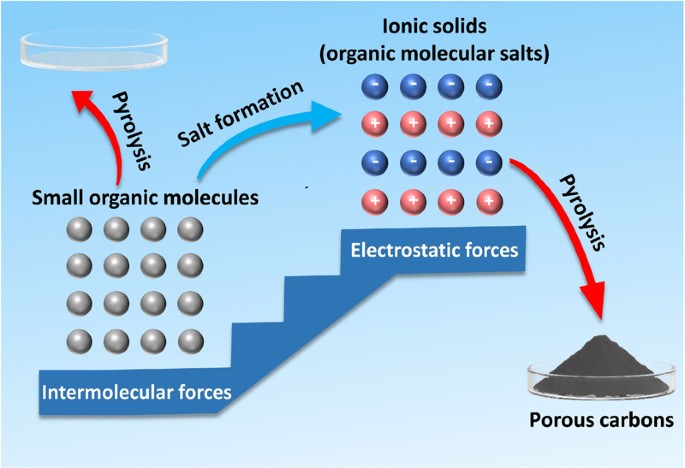Aqueous zinc-air battery (Zinc-air Battery, ZAB) has the advantages of high energy density, high safety, low cost, etc., and is a promising energy storage technology. Current zinc-air batteries mainly use high-concentration alkaline solutions as electrolytes, and a series of problems, such as poor chemical stability and electrochemical reversibility of metallic zinc anodes in alkaline electrolytes, low utilization rates, and the production of zinc dendrites; The oxygen reduction reaction (ORR) and oxygen evolution reaction (OER) of the air cathode have poor kinetics, which leads to severe electrochemical polarization; the alkaline electrolyte easily interacts with the CO2 in air electrode to form insoluble carbonates, blocking gas diffusion and reactive sites. To avoid over-reliance on high-cost, low-reserve traditional precious metal (Pt, Ir/Ru-based) catalysts, the development of low-cost, high-abundance transition metal-based compounds has become an important direction for the development of ZAB catalysts.
In response to the serious challenges of ORR and OER reaction polarization of air electrodes, Fan Liangdong's research group at Shenzhen University has achieved a series of research results in recent years by modifying perovskite oxide electrodes with intrinsic versatile structures and compositions through surface modification and forming composite heterostructural electrodes. Relevant research results have been published in high-level journals such as Applied Catalysis B: Environmental, Materials Today Nano, Journal of Materials Chemistry A, Nano Research, Fuel, and Current Opinion on Electrochemistry, etc.
In 2020, considering the low electronic conductivity characteristics of common perovskite oxide materials at room temperature, Fan Liangdong's research group smartly used the metal/alloy (NiCo) precipitated on the surface of perovskite as a bridge to deposit carbon nanotubes (CNT) on the surface of perovskite through chemical vapor deposition. The obtained oxide-metal-carbon nanotube composite effectively improved the electrocatalytic ORR activity of perovskite oxide in alkaline electrolytes. The half-wave potential reaches 0.83V, and the kinetic parameter Tafel slope value is 53 mV/dec, the open circuit voltage of 1.57V and the maximum power density of 115 mW/cm2 are also given in the real ZAB. The relevant properties are close to commercial Pt/C electrode materials. The results were published in Applied Catalysis B: Environmental 263 (2020) 118297, a highly-ranked journal with a journal impact factor of 16.683. The first author of the paper is postdoctoral fellow Li Fengjiao, Fan Liangdong, and Professor Chen Ming from General Motors are the co-corresponding authors, and Shenzhen University is the first corresponding affiliation.

Full-text link:https://doi.org/10.1016/j.apcatb.2019.118297
In the previous work, part of the perovskite oxides was decomposed under the typical carbothermal reduction condition, which limited the expression of the intrinsic activity of the perovskite oxide material, and enabled the ORR single functionality. Research results titled "NCNT grafted perovskite oxide as an active bifunctional electrocatalyst for rechargeable zinc-air battery" were published with Shenzhen University as the first affiliation in Materials Today Nano 21 (2023) 100287 (Journal Impact Factor: 13.364). Postdoctoral fellow Li Fengjiao of Shenzhen University is the first author, and Professor Fan Liangdong of Shenzhen University and General Motors Professor Chen Ming are the co-corresponding authors.


In this work, Fan Liangdong's research group first screened stable La0.8Sr0.2Ti0.65Fe0.35O3-d and then used a one-step self-assembly process to obtain La0.8Sr0.2Ti0.65Fe0.35O3-d-nitrogen doped carbon nanotube (LSFT-NCNT) composite. The LSFT-NCNT electrode that effectively maintains the perovskite phase structure not only improves the catalytic ORR activity in alkaline electrolytes but also introduces new functionality of OER performance, that is, it shows excellent bifunctional oxygen electrocatalytic activity. The specific performances are as follows: the onset voltage of ORR is 0.992V, the half-wave potential is 0.86V, the tafel slope is 63mV/dec with the limited current density of 6.07mA/cm2, which are far beyond the unmodified electrode and commercial Pt/C electrode; regarding the OER performance, The overpotential required for active 10mA/cm2 current density is 390mV, which is superior to commercial IrO2/C material. In addition, the ZAB based on the above-mentioned LSFT-NCNT electrocatalyst showed good stability after charge and discharge cycling for 42 hours at a current density of 10 mA/cm2 (changing operational mode every 20 minutes). Theoretical calculations found that the electron transfer from NCNT to the Fe active center results in significantly reduced oxygen surface adsorption and activation energy and strengthens the Fe 3d and O 2p orbital hybridization to improve the OER activity.
Full-text link:https://doi.org/10.1016/j.mtnano.2022.100287
Constructing metal-perovskite oxide heterostructure materials is an important means to effectively improve oxygen electrocatalytic activity. However, the interface length constructed by existing technologies such as impregnation and exsolution processes is limited or the interfacial interaction is weak, which limits the performance of high intrinsic catalytic activity. A publication entitled "Nano and phase engineering of Fe-Cu alloy exsolved perovskite oxide-based hetero-catalysts for efficient oxygen evolution reaction" was recently published in Fuel (Journal impact factor 7.4). This work is led by Huang Jiajia, a master's student at Shenzhen University, as the first author, Fan Liangdong of Shenzhen University, Qiu Te-Wei of Taipei University of Technology, and Beijing Institute of Technology Li Fengjiao are the co-corresponding authors. Shenzhen University is the first communications affiliation.


In this work, Fan Liangdong's research group simultaneously integrated nano and phase structure engineering technologies, using phase transformation and electrospinning processes to maximize the FeCu alloy segregation driving force and reduce the bulk cation migration distance, significantly improving the metal/alloy exsolution on/to the perovskite oxide surface and leading to maximized metal-perovskite oxide heterostructure interface. By adjusting the reduction temperature, a maximum of 20.8% of metal nanoparticles can be precipitated, and the simple perovskite SP: RP structure perovskite in the oxide composition phase can be controlled from 91.8%:8.2 to 0:100%. The optimal OER characteristic overpotential of the alloy nanoparticle-SP-RP composite material is only 381mV, which is much lower than that of the sample processed in air and it shows good catalytic OER stability.
Fuel-text link:https://doi.org/10.1016/j.fuel.2023.129479
In addition to developing non-noble metal electrocatalysts, Fan Liangdong’s group also collaborated with Professor Liang Hai-Wei of the University of Science and Technology of China. They convert organic molecules, to organic molecular salt compounds, which significantly reduces the volatilization of organic small molecules and, therefore, maximizes the carbon residual capacity. Utilizing the in-situ template or pore-forming function of the metal moiety in the organic salt, they achieved a simple, versatile, and controllable method to prepare porous structural carbon nanomaterials. The modular structure was used to adjust the porosity and realize the molecular level doping of heterogeneous elements. Subsequently, the porous structural carbon material was used as the substrate to support an intermetallic PtCo catalyst, achieving a mass activity as high as 1.62 A/mgPt. The research results provide a new method for realizing tailor-made porous carbon synthesis at the molecular level. The full text of the paper "Building the Bridge of Small Organic Molecules to Porous carbons via Ionic Solid Principle" was published in the domestic flagship journal Nano Research (journal impact factor: 10.269).


Full-text link:https://doi.org/10.1007/s12274-022-4997-8
In addition to developing active oxygen electrocatalysts, Fan Liangdong's research group also made effort to develop active catalysts for the hydrogen evolution half-reaction (HER). Using melamine, cyanuric acid, and ammonium molybdate as raw materials, unusual 2D structural a-MoC and η-Mo2C with regular "pores in the sheet" were synthesized through simple ball milling mixing, self-assembly process, and heat treatment process. The catalyst exhibits even better HER activity than common β-Mo2C and commercial Pt/C in acid or alkaline electrolyte systems. Corresponding theoretical calculations confirm that N element doping optimizes the Gibbs free energy of hydrogen intermediate state adsorption and desorption states, a key step in HER. Integrating with the enhanced 2D and unique mesopore structure characteristics with significantly improved charge and mass transfer, exceptional electrocatalytic reaction kinetics are achieved. Research results were published entitled "Unconventional molybdenum carbide phases with high electrocatalytic activity for hydrogen evolution reaction" and "Coupled molybdenum carbide and nitride on carbon nanosheets: An efficient and durable hydrogen evolution electrocatalyst in both acid and alkaline Media" on classic material journal Journal of Materials Chemistry A (journal impact factor 11.301) and International Electrochemical Society journal: Electrochimica Acta (Journal impact factor 5.383).


Full-text link: http://dx.doi.org/10.1039/C9TA04374H
https://doi.org/10.1016/j.electacta.2018.05.129.
The above research work and results were financially supported by the National Natural Science Foundation of China (22378268, 51702220 and 51402093), the Natural Science Foundation of the Guangdong Province (2021A1515012356), the University Scientific Research Project of the Department of Education, Guangdong Province (2019KTSCX151), and Natural Science Foundation of Shenzhen (JCYJ20180305125247308) and Shenzhen University-Taipei University of Technology Joint Research Project (SZU-NTUT, 2023011).
